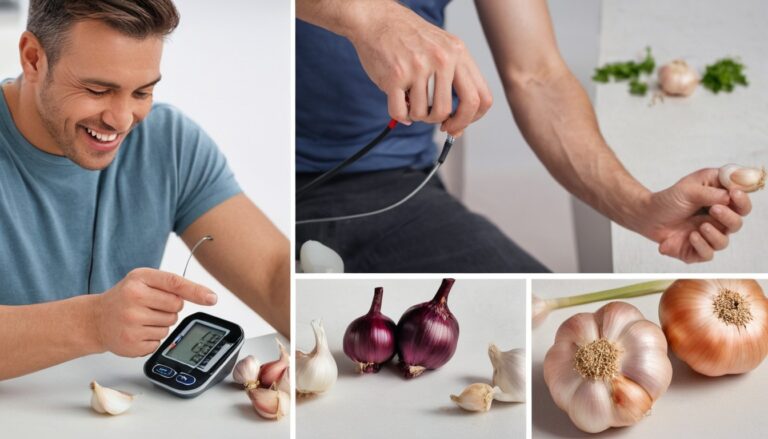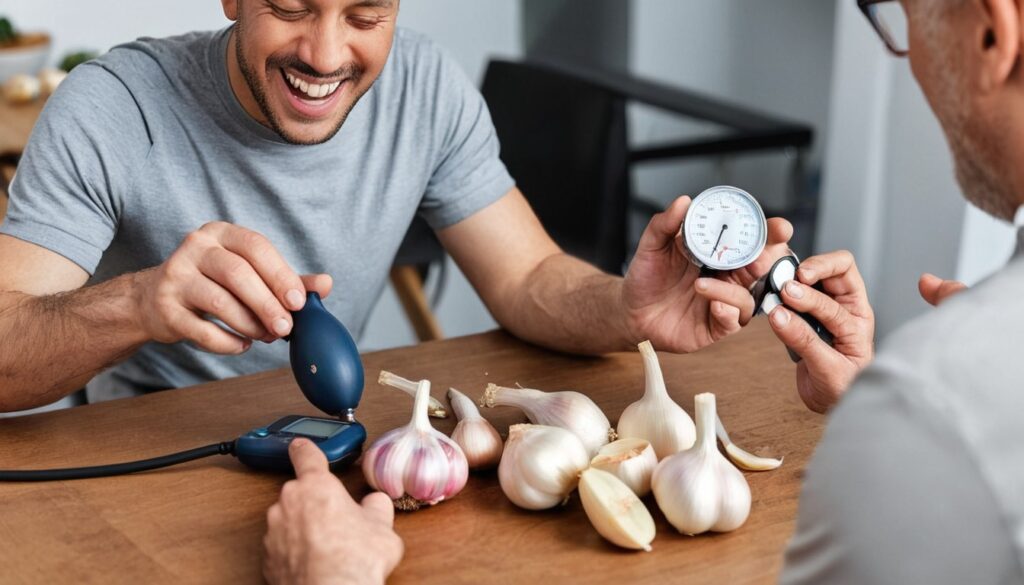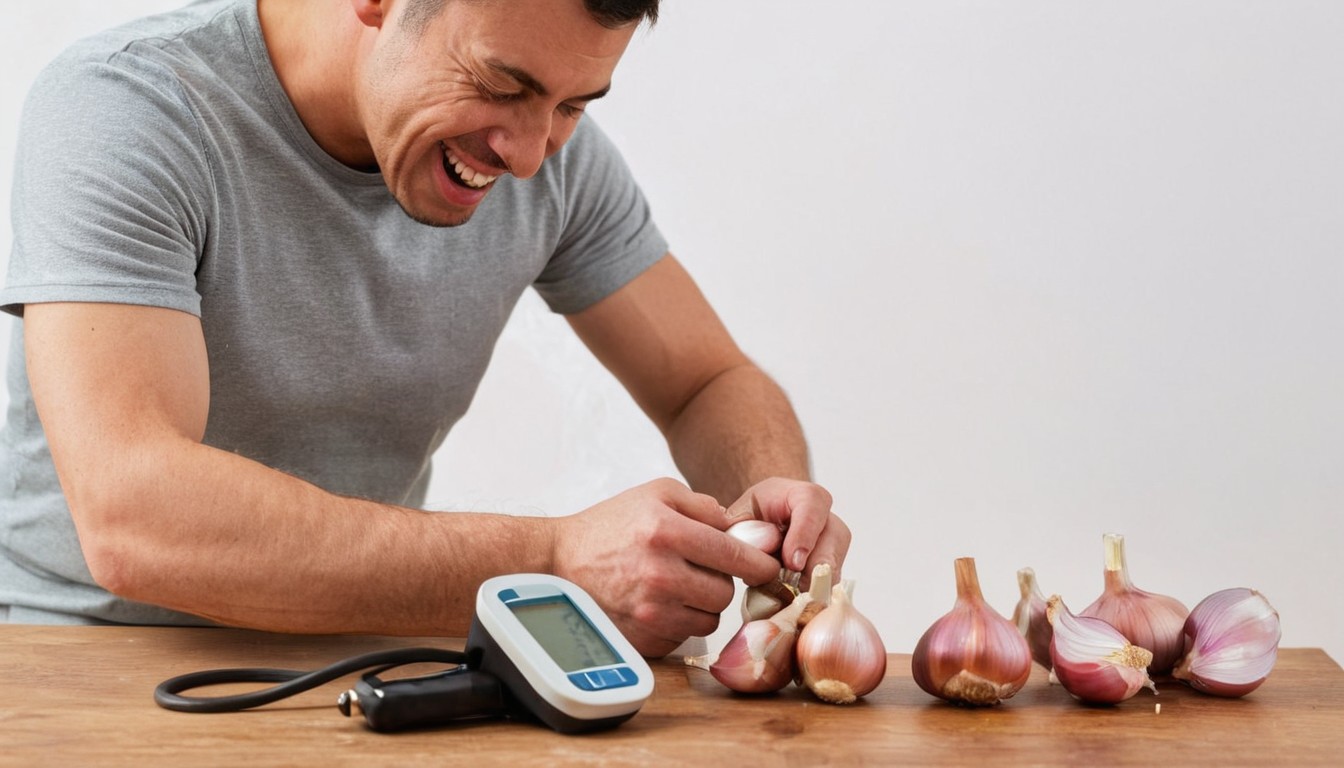Garlic, often referred to as the “stinking rose,” has been celebrated for its culinary and medicinal properties for centuries. Beyond its distinctive flavor and aroma, garlic boasts a myriad of health benefits that have been recognized across various cultures and traditions. In this comprehensive guide, we delve into the remarkable health benefits of garlic, with a particular focus on its role in lowering blood pressure.
Garlic has long been hailed as a natural remedy for an array of health issues, ranging from the common cold to cardiovascular disease. However, its efficacy in reducing blood pressure has garnered significant attention in recent years. As hypertension continues to be a prevalent health concern worldwide, many individuals are seeking natural alternatives to complement conventional treatments. This is where garlic emerges as a promising solution, offering a holistic approach to managing blood pressure levels.
Throughout this post, we will explore the science behind garlic’s blood pressure-lowering effects, examine the evidence supporting its use, and provide practical tips for incorporating garlic into your daily routine. By the end, you’ll have a deeper understanding of why garlic is not just a flavorful addition to your meals but also a potent ally in promoting heart health.

Understanding Garlic
Garlic, scientifically known as Allium sativum, is a species in the onion genus, Allium. It is native to Central Asia and has been cultivated for thousands of years for both culinary and medicinal purposes. Throughout history, garlic has held a revered position in various cultures around the world, valued not only for its distinct flavor but also for its potent healing properties.
Ancient civilizations, including the Egyptians, Greeks, Romans, and Chinese, recognized the therapeutic potential of garlic and incorporated it into their traditional medicine practices. It was used to treat a wide range of ailments, from infections and digestive issues to respiratory conditions and cardiovascular diseases. The ancient Greek physician Hippocrates, often referred to as the “father of medicine,” prescribed garlic for its medicinal benefits, highlighting its role in promoting overall health and well-being.
Nutritional Composition
Garlic is a powerhouse of nutrients, packed with vitamins, minerals, and bioactive compounds that contribute to its numerous health benefits. One of the key compounds found in garlic is allicin, a sulfur-containing compound formed when garlic is crushed or chopped. Allicin is responsible for the characteristic pungent odor and many of garlic’s medicinal properties.
In addition to allicin, garlic contains other sulfur compounds, such as diallyl disulfide, diallyl trisulfide, and ajoene, which exhibit antioxidant, anti-inflammatory, and antimicrobial properties. These sulfur compounds are believed to play a crucial role in garlic’s ability to combat oxidative stress, reduce inflammation, and boost immune function.
Garlic is also a good source of several vitamins and minerals, including vitamin C, vitamin B6, manganese, and selenium, which further contribute to its health-promoting effects. Additionally, garlic is low in calories and rich in fiber, making it a valuable addition to a balanced diet.
Overall, the nutritional composition of garlic, combined with its bioactive compounds, makes it a potent natural remedy with a wide range of therapeutic applications.
How Garlic Works to Lower Blood Pressure
Garlic exerts its blood pressure-lowering effects through multiple mechanisms, targeting various pathways involved in blood vessel function and cardiovascular health. One of the primary ways garlic contributes to lowering blood pressure is by promoting vasodilation, the widening of blood vessels, which allows for improved blood flow and reduced pressure against the vessel walls.
Role of Allicin in Vasodilation and Blood Pressure Regulation
Allicin, a sulfur-containing compound found in garlic, is often credited as one of the key components responsible for its medicinal properties, including its ability to lower blood pressure. When garlic is crushed, chopped, or chewed, an enzyme called alliinase converts the compound alliin into allicin. This process releases the characteristic pungent odor and activates the therapeutic effects of garlic.
Allicin has been shown to stimulate the production of nitric oxide (NO) in the endothelial cells lining the blood vessels. Nitric oxide is a signaling molecule that plays a crucial role in regulating vascular tone and promoting vasodilation. By increasing NO production, allicin helps relax and widen the blood vessels, leading to improved blood flow and decreased resistance, which in turn lowers blood pressure.
Furthermore, allicin exhibits antioxidant properties, scavenging free radicals and reducing oxidative stress within the blood vessels. Oxidative stress is known to contribute to endothelial dysfunction, inflammation, and vascular damage, all of which are implicated in the development of hypertension. By neutralizing free radicals and reducing oxidative damage, allicin helps preserve the integrity of the blood vessel walls and supports overall vascular health.
In addition to allicin, other sulfur compounds found in garlic, such as diallyl disulfide and diallyl trisulfide, also contribute to its blood pressure-lowering effects through similar mechanisms. These compounds work synergistically to enhance the vasodilatory response, improve endothelial function, and regulate blood pressure.
Overall, the collective action of garlic’s bioactive compounds, particularly allicin, on vascular function and blood pressure regulation underscores its potential as a natural approach to managing hypertension and promoting cardiovascular health.
Scientific Evidence of Garlic in Lowering Blood pressure
Numerous scientific studies have investigated the potential of garlic as a therapeutic agent for managing hypertension, with many demonstrating promising results in support of its use.
A meta-analysis published in the journal “BMC Cardiovascular Disorders” examined the findings of 20 randomized controlled trials involving over 900 participants. The analysis concluded that garlic supplementation was associated with a significant reduction in both systolic and diastolic blood pressure compared to placebo. The researchers attributed this effect to garlic’s ability to promote vasodilation and improve endothelial function.
Another study, published in the “Journal of Clinical Hypertension,” evaluated the long-term effects of garlic supplementation on blood pressure in individuals with uncontrolled hypertension. Over a 12-week period, participants who received garlic extract experienced a significant decrease in blood pressure compared to those who received a placebo. Additionally, the study found that garlic supplementation was well-tolerated and did not cause any adverse effects.
Furthermore, a systematic review published in the “American Journal of Hypertension” analyzed data from 11 clinical trials involving hypertensive patients. The review found consistent evidence supporting the use of garlic as an adjunctive therapy for lowering blood pressure, particularly in individuals with mild to moderate hypertension. The researchers concluded that garlic supplementation could be a valuable addition to conventional antihypertensive treatment regimens.
Overall, these studies provide compelling evidence for the efficacy of garlic in reducing blood pressure and supporting cardiovascular health. While more research is needed to elucidate the optimal dosage and duration of garlic supplementation, the existing evidence suggests that garlic holds promise as a natural and cost-effective approach to hypertension management.

Incorporating Garlic into Your Diet
Garlic is not only a flavorful addition to dishes but also a potent ingredient with numerous health benefits, including its ability to lower blood pressure. Here are some practical tips for incorporating garlic into your diet to maximize its medicinal properties:
1. Fresh Garlic Cloves: Use fresh garlic cloves in your cooking whenever possible. To release the beneficial compounds, crush or mince the garlic cloves and let them sit for a few minutes before adding them to your recipes.
2. Sauteed and Stir-Fried Dishes: Garlic adds depth of flavor to sauteed and stir-fried dishes. Start by heating olive oil or a healthy cooking oil in a pan, then add minced garlic and your favorite vegetables or protein. Cook until fragrant and golden brown for a delicious and nutritious meal.
3. Roasted Garlic: Roasting garlic enhances its sweetness and mellows out its pungent flavor. Simply slice off the top of a whole garlic bulb to expose the cloves, drizzle with olive oil, wrap in foil, and roast in the oven until soft and caramelized. Use roasted garlic as a spread on toast or incorporate it into mashed potatoes, soups, or pasta dishes.
4. Garlic Infused Oil: Make your own garlic-infused oil by heating olive oil and gently simmering whole garlic cloves until golden brown. Strain the garlic cloves and use the infused oil for salad dressings, marinades, or dipping sauces.
5. Raw Garlic in Salads and Salsas: For a potent dose of garlic’s health benefits, add raw minced garlic to salads, salsas, or homemade dressings. Pair it with fresh herbs, lemon juice, and olive oil for a vibrant and flavorful dressing that complements a variety of dishes.
6. Garlic Supplements: If you’re not a fan of the taste or odor of garlic, consider taking garlic supplements in the form of capsules or tablets. Look for supplements standardized to contain allicin or other active compounds for maximum efficacy.
Recipe Ideas:
Garlic Lemon Herb Chicken: Marinate chicken breasts in a mixture of minced garlic, lemon juice, olive oil, and herbs such as thyme, rosemary, and oregano. Grill or bake until cooked through for a flavorful and healthy protein option.
Garlic and Herb Roasted Vegetables: Toss your favorite vegetables, such as bell peppers, zucchini, and broccoli, with minced garlic, olive oil, salt, and pepper. Roast in the oven until tender and caramelized for a delicious side dish.
Garlic and White Bean Dip: Blend cooked white beans with roasted garlic, lemon juice, olive oil, and a pinch of cumin for a creamy and nutritious dip. Serve with sliced vegetables or whole grain crackers for a satisfying snack.
Incorporating garlic into your diet is not only easy and delicious but also offers a natural way to support your cardiovascular health and lower blood pressure.

Precautions and Considerations
While garlic is generally safe for most people when consumed in moderation as a food ingredient, there are some precautions and considerations to keep in mind, especially when using garlic supplements for blood pressure management.
1. Gastrointestinal Discomfort: In some individuals, consuming large amounts of raw garlic or garlic supplements may cause gastrointestinal discomfort, such as bloating, gas, or heartburn. To minimize these effects, start with small doses and gradually increase intake over time.
2. Garlic Breath and Body Odor: Garlic consumption can lead to strong breath and body odor, which may be unpleasant for some individuals. Chewing parsley, mint, or citrus fruits can help mask the odor temporarily.
3. Blood-Thinning Effects: Garlic has natural blood-thinning properties, which may increase the risk of bleeding, especially when taken in high doses or combined with other blood-thinning medications, such as warfarin or aspirin. Individuals on blood-thinning medications should consult their healthcare provider before using garlic supplements.
4. Medication Interactions: Garlic supplements may interact with certain medications, including anticoagulants, antiplatelet drugs, and protease inhibitors. Garlic may potentiate the effects of these medications, leading to an increased risk of bleeding or other adverse effects. Additionally, garlic may interact with medications used to treat HIV/AIDS, leading to reduced efficacy. It is essential to discuss any potential interactions with a healthcare professional before starting garlic supplementation.
5. Allergic Reactions: While rare, some individuals may experience allergic reactions to garlic, resulting in symptoms such as skin rash, itching, or difficulty breathing. If you have a known allergy to garlic or other members of the Allium family, such as onions or leeks, avoid garlic consumption and consult with a healthcare provider.
6. Garlic Supplements During Pregnancy and Breastfeeding: Pregnant and breastfeeding women should exercise caution when using garlic supplements, as there is limited safety data available. While garlic is generally recognized as safe when consumed in food amounts, the safety of high-dose garlic supplements during pregnancy and lactation has not been well studied. It is advisable to consult with a healthcare provider before using garlic supplements during these stages.
In conclusion, while garlic offers numerous health benefits, including its potential to lower blood pressure, it is essential to use it cautiously and be aware of potential side effects and interactions, particularly when using garlic supplements or in high doses. Consulting with a healthcare professional before starting any new supplement regimen is advisable, especially for individuals with underlying health conditions or those taking medications.

Conclusion
In conclusion, garlic emerges as a powerful ally in the quest for better cardiovascular health, particularly in the management of high blood pressure. Through its unique combination of bioactive compounds, including allicin and sulfur compounds, garlic exhibits vasodilatory effects, improves endothelial function, and helps regulate blood pressure levels.
Scientific evidence supports the use of garlic as a natural and effective adjunctive therapy for hypertension management. Clinical studies have demonstrated that garlic supplementation can lead to significant reductions in both systolic and diastolic blood pressure, with minimal side effects and excellent tolerability.
By incorporating garlic into your diet on a regular basis, whether through fresh cloves, cooked dishes, or supplements, you can harness its full potential for promoting heart health and lowering blood pressure. From sauteed vegetables to roasted chicken, there are countless delicious ways to enjoy the flavor and benefits of garlic in your meals.
However, it is essential to exercise caution and consult with a healthcare professional, especially if you are taking medications or have underlying health conditions. Garlic supplements, in particular, may interact with certain medications and pose risks for individuals with bleeding disorders or allergies.
In conclusion, while garlic is not a substitute for medical treatment, it can serve as a valuable addition to a comprehensive approach to cardiovascular health. By embracing garlic as part of a balanced diet and healthy lifestyle, you can take proactive steps towards maintaining optimal blood pressure levels and overall well-being.

Nutrition Blogger
I am a Health/Wellness and Nutrition Blogger. Bringing you well-researched details on your nutrition and health information. I love Helping you enjoy good health with the right choice of food.
Disclaimer
The information provided on this page is intended for general informational purposes only and was gathered by research on general nutrition science and experiments. The content is not intended to be a substitute for your specific professional medical, nutritional, or fitness advice, diagnosis, or treatment.
Recent Posts
- 7 Surprising Reasons Why You Need a Balanced Diet Every Day as a Woman
- The Mediterranean Diet and Dementia: Protecting Brain Health
- Superfoods for Brain Health: Diet To Fight Dementia
- Nutritional Strategies for Managing Dementia Symptoms
- How To Recognize Early Signs and Symptoms of Dementia
- Managing Lewy Body Dementia: Understanding Symptoms and Nutrition
- Understanding Vascular Dementia: Causes, Symptoms, and Dietary Solutions
- Alzheimer’s Disease and The Right Diet: All You Need To Know
- Dementia vs. Normal Aging: Debunking Myths and Clarifying Realities
- What are The Risk Factors for Dementia?
- Dementia And Omega 3 Fatty Acid ( Eicosapentaenoic acid )
- The Role of Nutrition in Dementia Prevention
- Dementia: An Introduction to the Condition and Management
- Okra Extract Supplements: A Nutrient-Rich Addition to Your Wellness Routine
- Okra and Eye Health: Okra and Vitamin A for Clear Vision
- Fuel Your Fitness: Okra’s Role in Sustaining Energy and Enhancing Muscle Recovery
- Age Gracefully with Okra: Supporting Joint Health in the Elderly
- Slim Down with Okra: Low-Calorie Smoothie Recipes
- Why Okra is a Must-Have for Pregnant Mom: The Folate Advantage
- DIY Beauty: Okra-Based Face Masks for Radiant Skin
- Boosting Milk Supply: The Okra Advantage for Nursing Moms
- Boost Your Child’s Growth with Okra: A Nutrient-Packed Superfood
- How Okra Supports Cycle Regularity: The Menstrual Miracle
- Boosting Testosterone Naturally: The Role of Okra in Men’s Health
- Detox Delight: How Okra Supports Your Body’s Natural Cleansing Process
- How Okra Fights Cancer: Okra and Cancer Prevention
- Explore 10 Health Benefits Of Garlic: A Comprehensive Guide
- Health Benefits of Garlic for Fighting Cough and Cold Infections
- Can Garlic Be Used As a Natural Antibiotic?
- How Effective is Garlic in Lowering Cholesterol And Improving Heart Health?
- Garlic’s Brain Boost: Protecting Against Alzheimer’s and Dementia
- Garlic: Your Gut’s Best Friend – Enhance Digestion Naturally
- Unveiling the Immune-Boosting Powers of Garlic
- Using Garlic to Lighten Acne Scars Naturally: Skin Nutrition
- Beating Ulcers Naturally: The Garlic Solution
- Adding Garlic to Your Athletic Nutrition Routine.
- Garlic vs. UTI: Natural Remedy for Urinary Tract Infections
- How to Combat Exercise Fatigue with Garlic: The Science Behind it
- The Power of Garlic: Safely Reducing Blood Toxicity
- Garlic: A Natural Solution for Oestrogen Deficiency
- Garlic’s Role in Osteoarthritis Management: A Natural Remedy for Joint Health
- Platelet Power: Garlic’s Role in Preventing Heart Blockages
- Harnessing Garlic’s Power: 5 Health Benefits You Need to Know
- Unlocking the Secrets of Garlic in Preventing Thromboembolism
- Unlocking Garlic’s Potential: A Natural Approach to Lowering Blood Pressure
- Boosting Men’s Wellness: The Power of Garlic
- Explore The Incredible Benefits of Garlic for Women’s Health
- Treating Throat Disorders Naturally with Papaya
- Can Papaya Be Used Treatment For Ringworm?
- Can Cucumber Reduce the Risk of Cancer?
- Using Cucumber to Reduce Puffiness Around The Eyes.
- Using Cucumber For a Better Skin: Beauty Benefits of Cucumber.
- Are Cucumbers Helpful in Weight Loss?
- Can Cucumber Help Reduce Blood Sugar and Manage Diabetes?
- How can I improve my digestion with Cucumber?
- Unveiling Cucumbers’ Secrets for Hair and Nails: From Salad Bowl to Beauty Regimen
- Can Papaya Help Treat Piles? Hemorrhoids Natural Relief.
- Refreshing Solutions: Cucumbers for Bad Breath.
- Can Cucumber Help Regulate Blood Pressure?
- Cucumber: A Good Choice for Hydration and Detoxification
- How Papaya Can Help Reduce Lung Inflammation: Insights and Practical Tips
- Seniors’ Secret Weapon: Harnessing Cinnamon’s Health Benefits
- Transform Your Routine: Cinnamon for Beauty
- Discovering the Benefits of Cinnamon for Oral Hygiene
- Boost Your Workout: How Cinnamon Fuels Athletes.
- Unlocking the Weight Loss Potential of Cinnamon: A Comprehensive Guide
- Let’s Discuss Cinnamon Consumption During Pregnancy.
- Spicing Up Motherhood: Cinnamon Benefits for Nursing Moms
- Spice Up Your Child’s Diet: Fun Ways to Include Cinnamon in Meals
- Cinnamon: A Natural Remedy for Women’s Menstrual Health
- Using Cinnamon as a Natural Aphrodisiac: The Role of Cinnamon in the Infertility treatment and Sexual drive.
- Can Cinnamon Be Used in Treating Erectile Dysfunction?
- Can Eating Papaya Help Prevent Arthritis?
- Does papaya have Anticancer Effects?
- Can papaya Aids Digestion?
- Can Papaya Seeds Help Heal Wounds?
- How To Use Okra To Lose Weight and Reduce Belly Fat.
- How To Use Okra to Improve Capillaries Function.
- Can Okra Help Maintain a Healthy Heart and Prevent Heart Disease?
- Can Okra Help Prevent Constipation?
- How Can Okra Help Get Rid of Cholesterol?
- Can Okra Help Stabilize Blood Sugar and Prevent Diabetes?
- The Beauty Benefits of Okra for Hair, Skin, and Nails.
- How Okra Can Boost Women’s Health and Wellness.
- How Okra Can Boost Men’s Health: Unlocking the Nutritional Power of this Versatile Vegetable
- Different Ways to Include Okra to Your Diet
- Okra: Your Delicious Pathway to Vibrant Health and Culinary Delight!
- How Does Eating Papaya Boost Immunity?
- Preventing Macular Degeneration with Papaya. : Maintaining A Healthy Eye Vision
- Can Papaya Promotes Cardiovascular Health?
- How To Use Papaya To Condition Your Hair.
- Can Papaya Help in Controlling Dandruff?
- Can Papaya Stimulates Hair Growth?
- The Cognitive Benefits of Cloves for Brain Health.
- Can Cloves Alleviate Menstrual Discomfort and Regulate Menstrual Cycles?
- How To Use Papaya To Reduce Under-Eye Dark Circles.
- Can Papaya Help Reduce Skin Wrinkles?
- Can Papaya Help Clears Skin Pigmentation?
- Can Papaya Help Moisturize Dry Skin?
- Can Papaya Help Treat Eczema And Psoriasis?
- Does Clove Reduce Inflammation?Highlighting the Anti-inflammatory Properties of Cloves
- How to Cloves for Blood Circulation
- Boosts Athletic Performance With Cloves: Explore the Role of Cloves in enhancing Physical Performance and Recovery
- Can Cloves Aid The Liver in Detoxification?
- Is Cloves good for the Eyesight?
- Can Cloves Help Reduce Anxiety and Relieve Stress?
- Cloves and Gut Microbiota: Explore the effects of cloves on gut bacteria and overall gut health.
- Can Cloves Regulate Hormonal Imbalance? Examine the effects of Cloves on Hormone Regulation and Balance
- How to Choose the Right Fish Oil Supplements.
- Omega-3s and Skin Health: Unveiling the Secrets of a Radiant Complexion
- Pregnancy and Omega-3s: A Nutritional Guide for Expecting Moms
- Omega-3s for Athletes: Boosting Performance and Recovery
- Heart-Healthy Recipes: Cooking with Omega-3-Rich Ingredients
- Omega-3s for Brain Health: Nourishing Your Mind Naturally
- Does Plant-based Omega-3 Work? Nuts, Seeds, and Algae Oil Explained
- Omega-3 vs Omega-6: Striking the Right Balance for Heart Health
- Does Ginger Have Any Benefits for Skin and Beauty?
- DIY: Different Ways to Include Ginger in Your Drinks and Foods.
- What does ginger do to the brain?
- How to use ginger for morning sickness during pregnancy?
- Is Ginger a Natural Remedy for Post-Exercise Recovery?
- The Analgesic Benefits of Ginger: The Natural Pain Relief.
- Gut Health and Diverticulitis: Understanding the Connection
- Diverticulitis in Older Adults: Special Considerations and Tips for Seniors.
- Traveling with Diverticulitis: Staying Healthy on the Go
- Socializing as a Diverticulitis Patient: Navigating Events and Gatherings
- Cooking Tips for Diverticulitis Patients: Making Meals Digestible
- Recipes for Diverticulitis-Friendly Smoothies and Juices
- Diverticulitis and Weight Management: Tips for Healthy Living
- Stress Management for Diverticulitis: Techniques for Relaxation
- Exercise and Diverticulitis: Finding the Right Balance
- Fluid Intake and Diverticulitis: Staying Hydrated for Digestive Health
- Probiotics and Diverticulitis: Can They Help?
- Low-FODMAP Diet and Diverticulitis: What You Need to Know
- Free 7 Day Meal plan For Managing Diverticulitis: A Week of Nutrient-Rich Meals
- High-Fiber Diet for Diverticulitis: Benefits and Guidelines
- What are The Foods To Avoid If You Have Diverticulitis?
- The Role of Diet in Managing Diverticulitis
- Diagnosing Diverticulitis: Tests and Procedures
- What are the Signs and Symptoms of Diverticulitis?
- What are The Treatment Options for Diverticulitis, Medications and Procedures?
- What is The Link Between Diverticulosis and Diverticulitis?
- All You Need To Know About Diverticulitis and Diverticulitis Diet
- Can Ginger Relieve Menstrual Cramps?
- Can Ginger Help in Lowering Cholesterol Levels And Blood Pressure?
- Ginger As a Natural Remedy for Heartburn
- Can Ginger Help in Managing Glucose Levels?
- How Does Ginger Help With Weight loss?
- How Do Ginger Boost Immune System?
- Benefits of Ginger in Combating Chemotherapy-Induced Nausea
- Ginger and Digestive System: Benefits of Ginger.
- Does Ginger Help With Respiratory Problems?
- Can Cloves Help Manage Blood Sugar Levels?
- How do Cloves Benefit Women’s Health?
- How do Cloves Benefit Oral Health?
- What Are the Different Ways to Include Cloves into Your Diet
- What Are The Proven Health Benefits Of Cloves?
- Can Omega-3 Fatty Acids Alleviate Symptoms of Depression and Anxiety?
- What Are The Proven Benefits of Omega-3 Fatty Acids and Fish Oil?
- Can Omega-3 Fatty acids Alleviate Symptoms of Joint Pain and Stiffness?
- Are You Omega-3 Fatty Acids Deficient? How to Know and What to Do
- Do Omega-3 Fatty Acids reduce inflammation?
- What are the Best Sources of Omega-3 Fatty Acids?
- What Role do Omega-3 Fish oil, play in Brain Development and Mental Function?
- Can omega-3 fatty acids reduce the risk of Cardiovascular Disease?
- Cheers or Caution?: The Pros and Cons of Alcohol for Men’s Health
- Superfoods for Super Skin: Men’s Skin Health
- Immune-Boosting Foods for Men
- How to Prevent Hair Loss in Men: Mediterranean Delights
- How to Boost Testosterone Levels Naturally Through Diet for Men
- Healthy Snack Ideas for Busy Men on the Go
- Budget-Friendly Nutrition Hacks for Men
- Nutrients Every Aging Man Should Embrace
- Bone Health and Nutrition: Vital for Men’s Wellness
- How to Balance Work and Nutrition: Tips for Busy Men
- Understanding Men’s Metabolism and Its Impact on Nutrition
- 27 Foods That Fight Heart Disease: promoting Cardiovascular Wellness in men
- The Importance of Hydration for Men’s Health
- Heart-Healthy Habits: Preventing Cardiovascular Issues in Men
- Gut Health and Digestion: Tips for Men’s Health
- Understanding What Enlarged Prostate is: A Easy Guide for Men
- Enlarged Prostate Management: Treatment Options, Lifestyle Adjustment and Right Nutrients
- Can Your Plate Guard Your Prostate? : Enlarged Prostate Management with the right Food
- Elevate Men’s Health: Enlarged Prostate Myths
- Exercise for Men: Conquering Enlarged Prostate
- Performance Fuel: The Athlete’s Ultimate Nutrition Playbook : Men’s Health
- Smart Eats: Men’s Diet for Mental Clarity
- Navigating Men’s Weight Loss: Diet Strategies That Work: Men’s Health
- How Important is Protein for Men’s Health? Unveiling the Truth by Debunking the Myths: Men’s Health
- How to Build Muscle Mass Naturally for Men: Diet and Exercise Tips: Men’s Health
- Top 20 Superfoods Every Man Should Include in His Diet
- A Comprehensive Guide to Men’s Health and Nutrition Needs in Their 20s
- The Beauty Elixir: Guava Leaf Tea’s Secrets
- Guava Leaf Tea: A Natural Remedy for Digestive Wellness and Beyond
- Exploring Guava Leaf Tea’s Immune Boost
- DIY Guava Leaf Tea: How to Brew and Enjoy Its Medicinal Properties
- Unlocking the Power of Guava Leaf Tea: A Comprehensive Guide to Its Health Benefits
- Maximize Your Fitness: Unveiling the Power of Ginger for Enhanced Performance
- Balancing Stress: A Guide to Managing It with Diet, stress management revealed
- Papaya Bathing: The Surprising Secret to Glowing Skin: papaya and skin benefits
- How To Lower Blood Sugar By Adding Omega-3 fatty Acids: The Role of Omega-3 Fatty Acids
- Eicosapentaenoic Acid EPA: Omega-3’s Benefits
- Fiber for A Diabetes Diet: Control and Health Boost
- Prediabetes Diet Plan: Healthy Eating Guide
- Mastering Diabetic Meal Prep and Menus
- 10 Essential Nutrients for Diabetic Diet
- The Complete Guide to Creating a Nutrient-Packed Diet for Diabetes Management
- Bragg’s ACV Review: My Transformation Journey
- Weight Loss Teas – Fact or Fiction?
- Gastric Sleeve First-Pass Metabolism: Post-Surgery Health and Optimizing Recovery
- Mastering Mindful Eating: A Complete Guide to Transforming Your Relationship with Food
- 10 Wholesome and Handy Snacks for Busy Days: Nutritious Bites On the Go
- Oily Skin: How to Manage the Radiant Beauty
- Foods to Avoid After Prostate Surgery
- Keeping A Healthy Prostate The Right Nutrition: Prevention, Management, and Recovery
- 23 Excellent Foods to Boost Your Prostate
- Are fermented fruits and food healthy? : Benefits and Risks.
- 23 Amazing Foods high in potassium : Maintaining A healthy heart







